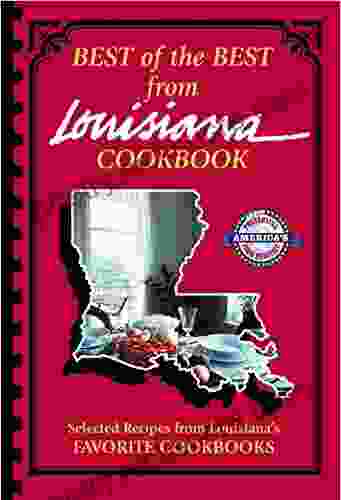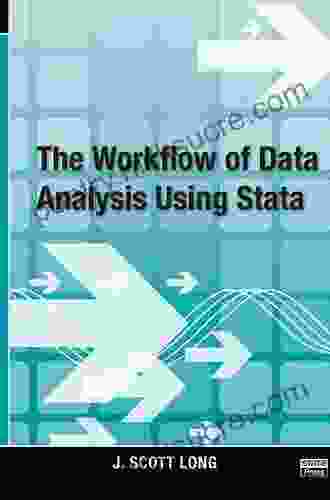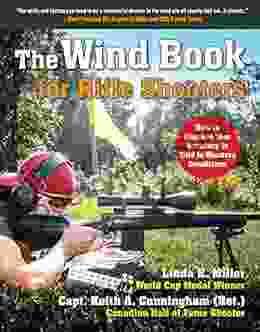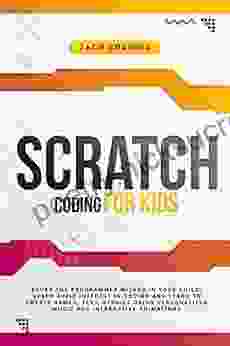The Comprehensive Guide to Data Analysis Using Stata: A Step-by-Step Workflow

4.5 out of 5
| Language | : | English |
| File size | : | 157280 KB |
| Text-to-Speech | : | Enabled |
| Screen Reader | : | Supported |
| Enhanced typesetting | : | Enabled |
| Print length | : | 379 pages |
Data analysis is a critical process for extracting meaningful insights from raw data. Stata is a powerful statistical software package that provides a wide range of tools for data analysis. This guide will provide a step-by-step workflow for data analysis using Stata, covering the following stages:
- Data cleaning
- Data exploration
- Data visualization
- Data modeling
- Data interpretation
- Data reporting
Step 1: Data Cleaning
Data cleaning is the process of identifying and correcting errors and inconsistencies in raw data. This step is crucial for ensuring the accuracy and reliability of your analysis.
In Stata, you can use the following commands to clean your data:
- list: Display the data in a table format.
- summarize: Summarize the data by calculating descriptive statistics.
- tabulate: Create frequency tables and cross-tabulations.
- replace: Replace missing values or incorrect values.
- drop: Remove observations or variables from the dataset.
Step 2: Data Exploration
Data exploration is the process of understanding the structure and distribution of your data. This step helps you identify patterns, trends, and outliers that may be important for your analysis.
In Stata, you can use the following commands to explore your data:
- histogram: Create histograms to visualize the distribution of continuous variables.
- scatterplot: Create scatterplots to visualize the relationship between two continuous variables.
- boxplot: Create boxplots to visualize the distribution of continuous variables and identify outliers.
- tabstat: Create summary statistics for categorical variables.
Step 3: Data Visualization
Data visualization is the process of presenting your data in a graphical format. This step helps you communicate your findings in a clear and concise way.
In Stata, you can use the following commands to visualize your data:
- graph twoway bar: Create bar charts to visualize categorical data.
- graph twoway line: Create line charts to visualize continuous data.
- graph twoway scatter: Create scatterplots to visualize the relationship between two continuous variables.
- graph twoway boxplot: Create boxplots to visualize the distribution of continuous variables and identify outliers.
Step 4: Data Modeling
Data modeling is the process of using statistical models to describe the relationships between variables in your data. This step helps you predict outcomes and make inferences about your population.
In Stata, you can use the following commands to model your data:
- regress: Perform linear regression analysis.
- logistic: Perform logistic regression analysis.
- poisson: Perform Poisson regression analysis.
- anova: Perform analysis of variance.
Step 5: Data Interpretation
Data interpretation is the process of explaining the results of your statistical analysis. This step involves understanding the meaning of the coefficients, p-values, and other statistics that are generated by your models.
When interpreting your results, it is important to consider the following:
- The size and direction of the coefficients.
- The significance of the p-values.
- The goodness-of-fit statistics.
- The assumptions of the model.
Step 6: Data Reporting
Data reporting is the process of communicating your findings to others. This step involves writing a report or presentation that summarizes your analysis and provides insights into your data.
When reporting your results, it is important to be clear, concise, and accurate. You should also include relevant tables, graphs, and other visuals to support your findings.
Data analysis is a complex and iterative process. By following the steps outlined in this guide, you can use Stata to effectively analyze your data and extract meaningful insights.
Remember, the key to successful data analysis is to be systematic, patient, and curious. With practice, you will become proficient in using Stata and gain valuable insights from your data.
4.5 out of 5
| Language | : | English |
| File size | : | 157280 KB |
| Text-to-Speech | : | Enabled |
| Screen Reader | : | Supported |
| Enhanced typesetting | : | Enabled |
| Print length | : | 379 pages |
Do you want to contribute by writing guest posts on this blog?
Please contact us and send us a resume of previous articles that you have written.
 Fiction
Fiction Non Fiction
Non Fiction Romance
Romance Mystery
Mystery Thriller
Thriller SciFi
SciFi Fantasy
Fantasy Horror
Horror Biography
Biography Selfhelp
Selfhelp Business
Business History
History Classics
Classics Poetry
Poetry Childrens
Childrens Young Adult
Young Adult Educational
Educational Cooking
Cooking Travel
Travel Lifestyle
Lifestyle Spirituality
Spirituality Health
Health Fitness
Fitness Technology
Technology Science
Science Arts
Arts Crafts
Crafts DIY
DIY Gardening
Gardening Petcare
Petcare Steven Callahan
Steven Callahan Carl Mckeating
Carl Mckeating Lina Beard
Lina Beard Kennedy Achille
Kennedy Achille Stefanie Japel
Stefanie Japel Trevor Hartman
Trevor Hartman Good Books
Good Books Rebecca Carroll
Rebecca Carroll H Jerome Chapman
H Jerome Chapman Stephen Tarsitano
Stephen Tarsitano Margaret Jean Langstaff
Margaret Jean Langstaff Paul Logothetis
Paul Logothetis Ralph Cockburn
Ralph Cockburn Stefan Hollos
Stefan Hollos Gary Chapman
Gary Chapman Cade Courtley
Cade Courtley Hill Harper
Hill Harper Jennifer Kostick
Jennifer Kostick Les Livingstone
Les Livingstone Sandy Camillo
Sandy Camillo Janine Marsh
Janine Marsh Martin Meredith
Martin Meredith Jack Perconte
Jack Perconte James Burke
James Burke C W Farnsworth
C W Farnsworth Dr Sarita Uhr
Dr Sarita Uhr Henry Dillon
Henry Dillon Dean Buonomano
Dean Buonomano William P Young
William P Young Sarah Stodola
Sarah Stodola Chic Scott
Chic Scott Chris Gore
Chris Gore Joyce Meyer
Joyce Meyer Kalman Samuels
Kalman Samuels Jennifer Dugan
Jennifer Dugan John Edwards
John Edwards Judy Corry
Judy Corry John Pullen
John Pullen Mark Matlock
Mark Matlock John Van Wyhe
John Van Wyhe Jill Lepore
Jill Lepore Becky Wade
Becky Wade W W Sawyer
W W Sawyer Vittal S Anantatmula
Vittal S Anantatmula Julie Plagens
Julie Plagens Daniel Isberner
Daniel Isberner Lisa Randall
Lisa Randall James P Sethna
James P Sethna L J Smith
L J Smith Monroe Wildrose
Monroe Wildrose Elisabeth Haich
Elisabeth Haich Justine Gregory Williams
Justine Gregory Williams Roy M Wallack
Roy M Wallack Barry Dainton
Barry Dainton Ann Zaprazny
Ann Zaprazny Sally Connolly
Sally Connolly Wendy Leo Smith
Wendy Leo Smith G Norman Lippert
G Norman Lippert Todd Denault
Todd Denault Pierluigi Barrotta
Pierluigi Barrotta Stephen J Pyne
Stephen J Pyne Skeleton Steve
Skeleton Steve Neel Doshi
Neel Doshi Joy Dawson
Joy Dawson Sara Wickham
Sara Wickham Hope Comerford
Hope Comerford June Hur
June Hur Tanmay Mehta
Tanmay Mehta Shawn Shallow
Shawn Shallow Freddy Silva
Freddy Silva L J Martin
L J Martin Angela Saini
Angela Saini Timothy Ellis
Timothy Ellis Ann Valett
Ann Valett James F Twyman
James F Twyman Morton Manus
Morton Manus Jay Spence
Jay Spence Holly Bourne
Holly Bourne Sheela Raja
Sheela Raja Eric Greitens
Eric Greitens Katie Krimer Ma Lcsw
Katie Krimer Ma Lcsw Gilbert J Grant Md
Gilbert J Grant Md Jonathan Pd Buckley
Jonathan Pd Buckley Steven Yellin
Steven Yellin Paulo Guillobel
Paulo Guillobel Katharine Beals
Katharine Beals Nelson Dellis
Nelson Dellis Sukhveer Singh
Sukhveer Singh Jackie Bolen
Jackie Bolen David Soucie
David Soucie Malcolm S Thaler
Malcolm S Thaler Harnarayan Singh
Harnarayan Singh Bob Cary
Bob Cary Jenna Evans Welch
Jenna Evans Welch Scott Allan
Scott Allan Tony Osgood
Tony Osgood Richard A Swanson
Richard A Swanson John Dickson
John Dickson Roy R Grinker
Roy R Grinker Quinn Loftis
Quinn Loftis Illysa R Foster
Illysa R Foster Brian Daccord
Brian Daccord Anna Lowenhaupt Tsing
Anna Lowenhaupt Tsing Tarani Chandola
Tarani Chandola Suzanne Girard Eberle
Suzanne Girard Eberle Steven A Fino
Steven A Fino Heidi Kreider
Heidi Kreider Ralph Waldo Emerson
Ralph Waldo Emerson The Pinnacle Review
The Pinnacle Review Michael Witwer
Michael Witwer Naomi Tomky
Naomi Tomky George Lakoff
George Lakoff Ichigo Takano
Ichigo Takano Martin N Seif
Martin N Seif Ling Seto
Ling Seto Laurie Varga
Laurie Varga Lane Demas
Lane Demas Anna Flores Locke
Anna Flores Locke Steve Schwartz
Steve Schwartz Louis Van Dyke
Louis Van Dyke Hannah Testa
Hannah Testa Linda Lewis Alexander
Linda Lewis Alexander James C Zimring
James C Zimring Pawel Malczewski
Pawel Malczewski Mordecai Orimiladeye
Mordecai Orimiladeye Larry Thornberry
Larry Thornberry Sally Black
Sally Black Bren Smith
Bren Smith Kendall Coyne
Kendall Coyne Jason
Jason Luke Schumacher
Luke Schumacher Susan G Solomon
Susan G Solomon Rick Sparkman
Rick Sparkman Tyler Richards
Tyler Richards Neal Shusterman
Neal Shusterman P M Gilbert
P M Gilbert Lisa Manterfield
Lisa Manterfield Randy J Paterson
Randy J Paterson Antonio Robert
Antonio Robert Gemma Bray
Gemma Bray John O Sullivan
John O Sullivan Arcturus Publishing
Arcturus Publishing Julia Galef
Julia Galef David Berry
David Berry Geoff Greig
Geoff Greig Prime Hall
Prime Hall Larry Semento
Larry Semento Sam Demas
Sam Demas Annaka Harris
Annaka Harris Jonathan R Brennan
Jonathan R Brennan Lily Siou
Lily Siou Christelle Dabos
Christelle Dabos Mary E Pearson
Mary E Pearson Sparknotes
Sparknotes Ellen Dugan
Ellen Dugan Gwen Mckee
Gwen Mckee Rutger Bregman
Rutger Bregman Harold Davis
Harold Davis Bob Madgic
Bob Madgic Mike Roberts
Mike Roberts Marjorie Savage
Marjorie Savage Peyton Curley
Peyton Curley Peter Hathaway Capstick
Peter Hathaway Capstick Ken Robinson
Ken Robinson Charles Dickens
Charles Dickens Tali Sharot
Tali Sharot Suzanne I Barchers
Suzanne I Barchers Zach Codings
Zach Codings Kate Mcvaugh
Kate Mcvaugh Charlene Beswick
Charlene Beswick Sharman Apt Russell
Sharman Apt Russell Jessa Stone
Jessa Stone Curtis Collins
Curtis Collins Christopher T Coughlin
Christopher T Coughlin Kristen L Mauk
Kristen L Mauk Marie Cirano
Marie Cirano Tara Haelle
Tara Haelle Vladimir Vasiliev
Vladimir Vasiliev Ford R Bryan
Ford R Bryan Dave Hughes
Dave Hughes Peter Richmond
Peter Richmond Nancy Marie White
Nancy Marie White Geryn Childress
Geryn Childress Marva Boatman
Marva Boatman Victor Stringer
Victor Stringer Melvin Fitting
Melvin Fitting Dan Koboldt
Dan Koboldt Johnny Chuong
Johnny Chuong Michael G Manning
Michael G Manning Lori L Tharps
Lori L Tharps Stacey A Shannon
Stacey A Shannon Isaac Fitzsimons
Isaac Fitzsimons Cb Droege
Cb Droege Emily J Taylor
Emily J Taylor Linda K Miller
Linda K Miller Jay Allan
Jay Allan Julian Of Norwich
Julian Of Norwich Philip Gibson
Philip Gibson Howard Means
Howard Means Jay Young
Jay Young Barak A Bassman
Barak A Bassman Dave Whitlock
Dave Whitlock Graham Robb
Graham Robb Pradeepa Narayanaswamy
Pradeepa Narayanaswamy Helen Adrienne
Helen Adrienne Omari Bouknight
Omari Bouknight Illustrated Edition Kindle Edition
Illustrated Edition Kindle Edition Bert Mendelson
Bert Mendelson Chris Bailey
Chris Bailey Chase Hassen
Chase Hassen Kristian Berg
Kristian Berg Steve Newell
Steve Newell Nicholas Thomas
Nicholas Thomas Steve Oldenburg
Steve Oldenburg Frank Thomas
Frank Thomas Will Kurt
Will Kurt Darryl Belfry
Darryl Belfry Anna B Doe
Anna B Doe H M Schey
H M Schey Patricia Ladis
Patricia Ladis Rick Page
Rick Page Patricia Romanowski Bashe
Patricia Romanowski Bashe Scott Shupe
Scott Shupe Gloria Chadwick
Gloria Chadwick Louise Katz
Louise Katz Anna Watson
Anna Watson Nisha Garg
Nisha Garg Steve Olson
Steve Olson Jemar Tisby
Jemar Tisby Maya Van Wagenen
Maya Van Wagenen J E Esslemont
J E Esslemont Adele Faber
Adele Faber Ann Voskamp
Ann Voskamp Jeff Kuehl
Jeff Kuehl Finn Aagaard
Finn Aagaard Shannon Vallor
Shannon Vallor Kristina Cowan
Kristina Cowan Barbara Sealock
Barbara Sealock Rebecca A Moyes
Rebecca A Moyes Matthew Rudy
Matthew Rudy Charles J Sanders
Charles J Sanders Jacob Ward
Jacob Ward Silvia M Lindtner
Silvia M Lindtner Scott P Sells
Scott P Sells Creative Guy
Creative Guy Zoe Moore
Zoe Moore Ben Shneiderman
Ben Shneiderman Horace Freeland Judson
Horace Freeland Judson Anna Grafl
Anna Grafl Jennifer L Lopez
Jennifer L Lopez John Dunn
John Dunn Anna Ivey
Anna Ivey Horace Kephart
Horace Kephart Dorothy Ours
Dorothy Ours Clive Scarff
Clive Scarff Dave Canterbury
Dave Canterbury Sajni Patel
Sajni Patel John Baichtal
John Baichtal Zena Hitz
Zena Hitz Richard Appleton
Richard Appleton Holly Chism
Holly Chism Dave Hall
Dave Hall Lily Dunn
Lily Dunn Sean Covey
Sean Covey Asker Jeukendrup
Asker Jeukendrup Dante Fortson
Dante Fortson Damian Hall
Damian Hall Sean Purchase
Sean Purchase Alexander L Chapman
Alexander L Chapman Paul Bloom
Paul Bloom Caryl Phillips
Caryl Phillips Melanie Dickerson
Melanie Dickerson Jackson Carter
Jackson Carter Claire Walter
Claire Walter College Hippo
College Hippo Craig Ramsay
Craig Ramsay Julian Havil
Julian Havil Philip Reed
Philip Reed Sherry B Ortner
Sherry B Ortner Anna Della Subin
Anna Della Subin Steve Bennett
Steve Bennett Robert Gerver
Robert Gerver Maggie Downs
Maggie Downs Timothy P Schultz
Timothy P Schultz Jenn Bennett
Jenn Bennett Lexi Ryan
Lexi Ryan Douglas Perry
Douglas Perry Sean Bartram
Sean Bartram Kyung Won Chung
Kyung Won Chung Worley Faver
Worley Faver Chronicle Books
Chronicle Books E R Truitt
E R Truitt Bernard Stiegler
Bernard Stiegler Steven G Krantz
Steven G Krantz Sharon Rowley
Sharon Rowley Michael Burnett
Michael Burnett Robert F Boszhardt
Robert F Boszhardt Suzanne Clark
Suzanne Clark Barry Schwartz
Barry Schwartz Tim Young
Tim Young Darcie Little Badger
Darcie Little Badger Michael Tan
Michael Tan Oskar Morgenstern
Oskar Morgenstern Dr Harper
Dr Harper Reinhard Kleist
Reinhard Kleist Ann Marie Brown
Ann Marie Brown M Shawn Copeland
M Shawn Copeland Christina Henry De Tessan
Christina Henry De Tessan George James Grinnell
George James Grinnell Peter L Falkingham
Peter L Falkingham Junior Health Institute
Junior Health Institute Hanumant Deshmukh
Hanumant Deshmukh Harley Mcallister
Harley Mcallister Sally Annjanece Stevens
Sally Annjanece Stevens Barb Musick
Barb Musick C J Brown
C J Brown Tim Cahill
Tim Cahill Noel D Justice
Noel D Justice Michael F Nenes
Michael F Nenes Earl Hipp
Earl Hipp Chris Fregly
Chris Fregly Ariel Dalfen
Ariel Dalfen Julie Creffield
Julie Creffield Jean Barbre
Jean Barbre Thomas A Garrity
Thomas A Garrity Jonathan Franklin
Jonathan Franklin Susan Spicer
Susan Spicer John Yates
John Yates Robin Esrock
Robin Esrock Genevieve Mckay
Genevieve Mckay Helen E Lees
Helen E Lees R K Agarwal
R K Agarwal Anna Crowley Redding
Anna Crowley Redding Steve Grant
Steve Grant Emmett W Hines
Emmett W Hines Kathy Morey
Kathy Morey Anna Bright
Anna Bright Sandy Bodeau
Sandy Bodeau David Woods
David Woods Stephanie Cave
Stephanie Cave Frances Schultz
Frances Schultz Joanna Wells
Joanna Wells Stan Gibilisco
Stan Gibilisco Roger Hall
Roger Hall Dana James
Dana James Matthew Cobb
Matthew Cobb Michael Hodgson
Michael Hodgson Bethany Saltman
Bethany Saltman John Murray
John Murray Todd Radom
Todd Radom Livia Bitton Jackson
Livia Bitton Jackson Buddy Lee
Buddy Lee Ray Moynihan
Ray Moynihan L A Cotton
L A Cotton William Goldman
William Goldman Zach Davis
Zach Davis Stuart Tomlinson
Stuart Tomlinson Donna D Ignatavicius
Donna D Ignatavicius Glen E Clarke
Glen E Clarke Mishka Shubaly
Mishka Shubaly Annalyn Ng
Annalyn Ng Dan Vogel
Dan Vogel Robert A Conover
Robert A Conover Christine Field
Christine Field Robert A Cook
Robert A Cook Boye Lafayette De Mente
Boye Lafayette De Mente Randall Fitzgerald
Randall Fitzgerald R A Salvatore
R A Salvatore Walter Mischel
Walter Mischel Melissa Mortenson
Melissa Mortenson J Scott Long
J Scott Long Christine Hopfgarten
Christine Hopfgarten Richard C Schwartz
Richard C Schwartz Mike Reilly
Mike Reilly Peter Wacht
Peter Wacht Adil E Shamoo
Adil E Shamoo Julie C Meloni
Julie C Meloni Anna Quindlen
Anna Quindlen Margaret Rogerson
Margaret Rogerson Jenny Jacobs
Jenny Jacobs Winton Porter
Winton Porter Eddie Jones
Eddie Jones Valerie Hansen
Valerie Hansen Christopher Seddon
Christopher Seddon Krista Marson
Krista Marson Karen Bassie Sweet
Karen Bassie Sweet Eleanor J Sullivan
Eleanor J Sullivan James C Scott
James C Scott Breeda Bermingham
Breeda Bermingham Helge Kragh
Helge Kragh Annette Burns
Annette Burns Ellen Painter Dollar
Ellen Painter Dollar Steven Munatones
Steven Munatones Danny Jones
Danny Jones Miley Smiley
Miley Smiley Margaret Paul
Margaret Paul Paul Mendelson
Paul Mendelson Anna Wood
Anna Wood Cathy Glass
Cathy Glass Bob Labbe
Bob Labbe Fumio Sasaki
Fumio Sasaki John Gignilliat
John Gignilliat Seth Stephens Davidowitz
Seth Stephens Davidowitz Lizzie Collingham
Lizzie Collingham Aaron Mahnke
Aaron Mahnke Dan Gardner
Dan Gardner Matthew Locricchio
Matthew Locricchio Jacqueline Winslow
Jacqueline Winslow Anne Sylvie Malbrancke
Anne Sylvie Malbrancke Zach Hunter
Zach Hunter Richard A Ruth
Richard A Ruth Ann Mccallum Staats
Ann Mccallum Staats Michael Labossiere
Michael Labossiere Susan Straub
Susan Straub Patrick Torsell
Patrick Torsell Guy Windsor
Guy Windsor Julie A Ross
Julie A Ross Robby Weber
Robby Weber Shelley Emling
Shelley Emling Annabel Streets
Annabel Streets Joey Myers
Joey Myers Crystal Cook
Crystal Cook Stacey Williams
Stacey Williams Bella Forrest
Bella Forrest Alex Bromley
Alex Bromley Caroline Miller
Caroline Miller Ruby Mcconnell
Ruby Mcconnell Ian Moulding
Ian Moulding Fox Fisher
Fox Fisher Bruce Lockwood
Bruce Lockwood Joshua Shifrin
Joshua Shifrin M Terese Verklan
M Terese Verklan Dannah Gresh
Dannah Gresh Elizabeth Wissner Gross
Elizabeth Wissner Gross Daphne Poltz
Daphne Poltz Peter Watson
Peter Watson L Chapman
L Chapman Mikael Lindnord
Mikael Lindnord Mark Mckinney
Mark Mckinney Nicholas Clapp
Nicholas Clapp Gill James
Gill James Richard Mcafee
Richard Mcafee Sara Dyer
Sara Dyer Ray Eye
Ray Eye Josephine Mccarthy
Josephine Mccarthy Steve Bowkett
Steve Bowkett Kass Morgan
Kass Morgan Joe Hyams
Joe Hyams Wayne C Booth
Wayne C Booth Susan M Schneider
Susan M Schneider
Light bulbAdvertise smarter! Our strategic ad space ensures maximum exposure. Reserve your spot today!

 Nikolai GogolThe Best of the Best from Louisiana Cookbook: A Culinary Journey Through the...
Nikolai GogolThe Best of the Best from Louisiana Cookbook: A Culinary Journey Through the...
 Edward BellWhat You Don't Expect When You're Expecting: A Realistic Guide to the First...
Edward BellWhat You Don't Expect When You're Expecting: A Realistic Guide to the First...
 Davion PowellGraber and Wilbur Family Medicine Examination and Board Review Fifth Edition:...
Davion PowellGraber and Wilbur Family Medicine Examination and Board Review Fifth Edition:... Allan JamesFollow ·10.9k
Allan JamesFollow ·10.9k Jake PowellFollow ·11.2k
Jake PowellFollow ·11.2k Richard SimmonsFollow ·4.2k
Richard SimmonsFollow ·4.2k Ray BlairFollow ·17.2k
Ray BlairFollow ·17.2k Barry BryantFollow ·6k
Barry BryantFollow ·6k Dominic SimmonsFollow ·6.1k
Dominic SimmonsFollow ·6.1k Bryson HayesFollow ·17.1k
Bryson HayesFollow ·17.1k Isaias BlairFollow ·12.5k
Isaias BlairFollow ·12.5k

 Aldous Huxley
Aldous HuxleyMorgenstern: A Classic Tale of True Love and High...
Morgenstern is a...

 Beau Carter
Beau CarterThe Oasis Guide to Asperger Syndrome
What is Asperger Syndrome? Asperger...

 Chadwick Powell
Chadwick PowellFinding Your Way Through Loss Grief: A Therapist S Guide...
Grief is a natural human emotion that we...
4.5 out of 5
| Language | : | English |
| File size | : | 157280 KB |
| Text-to-Speech | : | Enabled |
| Screen Reader | : | Supported |
| Enhanced typesetting | : | Enabled |
| Print length | : | 379 pages |











